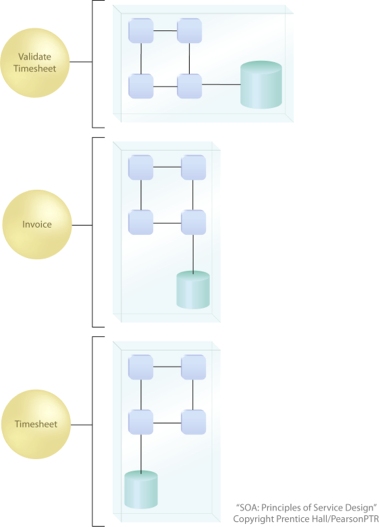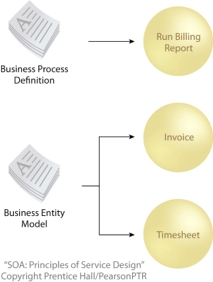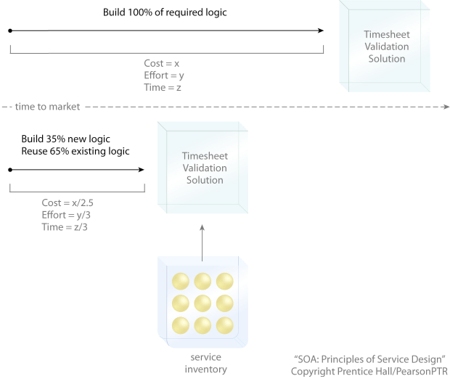
Summary taken from arcitura.com
SOA establishes an architectural model that aims to enhance the efficiency, agility, and productivity of an enterprise by positioning services as the primary means through which solution logic is represented in support of the realization of the strategic goals associated with service-oriented computing.
As a form of technology architecture, an SOA implementation can consist of a combination of technologies, products, APIs, supporting infrastructure extensions, and various other parts.
Goals and Benefits of Service-Oriented Computing
- Increased Intrinsic Interoperability
- Increased Federation
- Increased Vendor Diversification Options
- Increased Business and Technology Alignment
- Increased ROI
- Increased Organizational Agility
Increased Intrinsic Interoperability
A goal of service-orientation is to establish native interoperability within services in order to reduce the need for integration.
Interoperability is specifically fostered through the consistent application of design principles and design standards. This establishes an environment wherein services produced by different projects at different times can be repeatedly assembled together into a variety of composition configurations to help automate a range of business tasks.
Intrinsic interoperability represents a fundamental goal of service-orientation that establishes a foundation for the realization of other strategic goals and benefits. Contract standardization, scalability, behavioral predictability, and reliability are just some of the design characteristics required to facilitate interoperability.
Furthermore, the fact that services are designed to be intrinsically interoperable directly facilitates business change. As business processes are augmented in response to various factors (business climate changes, new competitors, new policies, new priorities, etc.) services can be reconfigured into new compositions that reflect the changed business logic. This allows a service-oriented technology architecture to evolve in tandem with the business itself.

Increased Federation
A federated IT environment is one where resources and applications are united while maintaining their individual autonomy and self-governance.

Increased Business and Technology Alignment
Service-oriented computing introduces a design paradigm that promotes abstraction on many levels. One of the most effective means by which functional abstraction is applied is the establishment of service layers that accurately encapsulate and represent business models. By doing so, common, pre-existing representations of business logic (business entities, business processes) can exist in implemented form as physical services.

Increased ROI
Service-oriented computing advocates the creation of agnostic solution logic – logic that is agnostic to any one purpose and therefore useful for multiple purposes. Agnostic services have increased reuse potential that can be realized by allowing them to be repeatedly assembled into different compositions. Any one agnostic service can therefore find itself being repurposed numerous times to automate different business processes as part of different service-oriented solutions.
With this benefit in mind, additional up-front expense and effort is invested into every piece of solution logic so as to position it as an IT asset for the purpose of repeatable, long-term financial returns. As shown in the following figure, the emphasis on increasing ROI typically goes beyond the returns traditionally sought as part of past reuse initiatives. This has much to do with the fact that service-orientation aims to establish reuse as a common, secondary characteristic within most services.

Increased Organizational Agility
Agility, on an organizational level, refers to efficiency with which an organization can respond to change. Increasing organizational agility is very attractive to corporations, especially those in the private sector. Being able to more quickly adapt to industry changes and outmaneuver competitors has tremendous strategic significance.
When service-orientation is applied throughout an enterprise, it results in the creation of services that are highly standardized and reusable and therefore agnostic to parent business processes and specific application environments.
As a result, the time and effort required to automate new or changed business processes is correspondingly reduced because development projects can now be completed with significantly less custom development effort.

The organization benefits from increased responsiveness after a significant amount of services is in place.
It is therefore important to acknowledge that service-orientation has a strategic focus that intends to establish a highly agile enterprise. This is different from agile development approaches that have more of a tactical focus due an emphasis on delivering solution logic more rapidly. From a delivery perspective, service-orientation does not tend to increase agility.